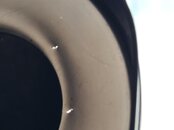Thanks again for the suggestions, you guys are really helping me out. In case it adds anything, the two holes in the diaphragm are about 12-13 mm apart.
After a dive trip, regs are thoroughly soaked at home in warm water for several hours while pressurized flush out the second stages with running water. They then dry overnight and then stored in a bin in a basement. The house and basement are climate controlled regs are stored where temp is slightly cool and pretty consistent, and I live in a dry climate. This has pretty much been the standard for 10-15 years and no problems have occurred previously. Based on the comments I have received,I think there are two likely issues
1. Have been diving quite a bit over the past few years with a particular operator who I think is not providing sufficient opportunity for me to rinse/soak regs daily, and also not taking care of gear after I am off the boat. Basically, when on that island, the routine is set up gear, head to reef and dive. SI of around 60 minutes, with gear sitting in sun and no ability to rinse or soak. Second dive and then about 45-60 minutes back to pier with gear sitting in sun. Get off boat, leaving reg on boat with dive op supposedly rinsing regs at some point. Increasingly, I don’t think that is happening. Repeat daily for several days, and then reg gets a brief soak or rinse before getting packed and not unpacked for 24-72 hours, usually.
2. The LDS that services our regs has a new tech they brought on about two years ago. I have no idea about his experience, skills or attitude.
I think I will use a different op on that island and I maystart taking a collapsible water bottle on boats that don’t offer an ability to rinse regs between and after dives. Then I can at least try to flush out the primary and octo before the salt water dries. I will also stop leaving my regs on the boats overnight even though I hate being “that guy.” Since I am always carrying a huge dive camera setup to and from the boat, dragging regs back and forth also is going to be a hassle.
If I can find someone that will sell me diaphragms, I will start packing a couple of spares. I also think I need to find a new place to take or send regs for service. Suggestions welcomed.




